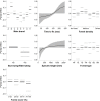Right on track? Performance of satellite telemetry in terrestrial wildlife research
- PMID: 31071155
- PMCID: PMC6508664
- DOI: 10.1371/journal.pone.0216223
Right on track? Performance of satellite telemetry in terrestrial wildlife research
Abstract
Satellite telemetry is an increasingly utilized technology in wildlife research, and current devices can track individual animal movements at unprecedented spatial and temporal resolutions. However, as we enter the golden age of satellite telemetry, we need an in-depth understanding of the main technological, species-specific and environmental factors that determine the success and failure of satellite tracking devices across species and habitats. Here, we assess the relative influence of such factors on the ability of satellite telemetry units to provide the expected amount and quality of data by analyzing data from over 3,000 devices deployed on 62 terrestrial species in 167 projects worldwide. We evaluate the success rate in obtaining GPS fixes as well as in transferring these fixes to the user and we evaluate failure rates. Average fix success and data transfer rates were high and were generally better predicted by species and unit characteristics, while environmental characteristics influenced the variability of performance. However, 48% of the unit deployments ended prematurely, half of them due to technical failure. Nonetheless, this study shows that the performance of satellite telemetry applications has shown improvements over time, and based on our findings, we provide further recommendations for both users and manufacturers.
Conflict of interest statement
I have read the journal's policy and the authors of this manuscript have the following competing interests: SN is employed by D.R.E.Am. Italia. JAM received funding from Bank of America, SCS from CIC Schweiz, FCA and FGL from Consórcio Capim Branco de Energia, and PK, BB, JCP from Sustainability East Asia LLC and Oyu Tolgoi mine. There are no patents, products in development or marketed products to declare. This does not alter our adherence to all the PLOS ONE policies on sharing data and materials.
Figures






References
-
- Thomas B, Holland JD, Minot EO. Wildlife tracking technology options and cost considerations. Wildl Res. 2011;38: 653–663.
-
- Eriksen A, Wabakken P, Zimmermann B, Andreassen HP, Arnemo JM, Gundersen H, et al. Activity patterns of predator and prey: A simultaneous study of GPS-collared wolves and moose. Anim Behav. Elsevier Ltd; 2011;81: 423–431. 10.1016/j.anbehav.2010.11.011 - DOI
Publication types
MeSH terms
Grants and funding
LinkOut - more resources
Full Text Sources

